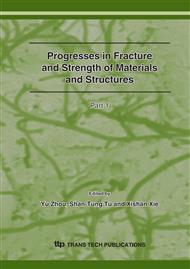p.174
p.178
p.182
p.186
p.190
p.195
p.199
p.203
p.207
Study on Life Prediction Method for Creep-Fatigue Interaction at Elevated Temperature
Abstract:
The law of low-cycle fatigue with hold time at elevated temperature is investigated in this paper. A new life prediction model for the situation of fatigue and creep interaction is developed, based on the damage due to fatigue and creep. In order to verify the prediction model, strain-controlled low-cycle fatigue tests at temperature 693K, 823K and 873K and fatigue tests with various hold time at temperature 823K and 873K for 316L austenitic stainless steel were carried out. Good agreement is found between the predictions and experimental results.
Info:
Periodical:
Pages:
190-194
Citation:
Online since:
September 2007
Authors:
Keywords:
Price:
Сopyright:
© 2007 Trans Tech Publications Ltd. All Rights Reserved
Share:
Citation:


